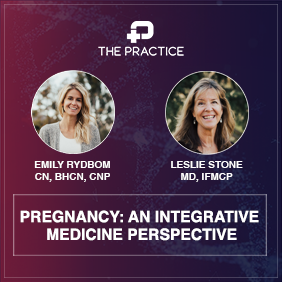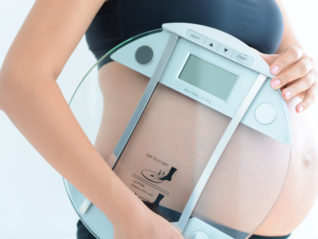
by Whitney Crouch, RDN, CLT
Women are often educated around the changes they’ll see in their bodies as they journey through pregnancy, however there tends to be a vast knowledge void when it comes to mother’s health and expectations after baby’s arrival.
Once the much-anticipated new addition has arrived, moms are followed up within six weeks after childbirth, likely asked about or given a questionnaire assessing postpartum depression symptoms, and physically evaluated by her care provider.1 The American College of Obstetricians and Gynecologists (ACOG) is recommending earlier follow up with mothers, within 3 weeks postpartum, and with ongoing care as needed.2
Mothers are not often educated around the effect of the large hormonal fluctuations that come with delivering a baby and the placenta.
Childbirth and hormone shifts
Hormones shift significantly during pregnancy, then again after delivery of the baby. When a woman is pregnant, levels of the female hormones estrogen and progesterone are the highest they’ll ever be. In the first 24 hours after childbirth, hormone levels quickly drop back down near normal, pre-pregnancy levels.3
This sudden reduction in progesterone and estrogen, as well as a rise in prolactin and oxytocin, are responsible for many physical and mental changes that are experienced by the new mother.3
Estrogen and progesterone
Changes in the hormonal mix cause women to experience various aesthetic side effects during pregnancy: pregnancy glow or pregnancy acne, and thicker, longer-growing hair.4
Estrogen levels reach nearly 1,000 times higher and progesterone levels increase 10-18 times than pre-pregnancy levels.5-6 Once baby is born and placenta is delivered, estrogen and progesterone levels plummet. In fact, they return to nearly normal levels within the days or week of delivery.5
Oxytocin and prolactin
Once baby is born, skin-to-skin time is encouraged to promote mother-baby bonding. During this time, oxytocin levels rise as baby cuddles and breast feeds.6-7 Oxytocin is often known as the baby-bonding hormone. It plays a role in many other emotions important to this delicate postpartum time, including reduction of stress, anxiety, and fear; pleasure and reward; and healing and growth.8
Maternal prolactin levels begin to rise during pregnancy and peak during the physiological onset of labor, which may be an important part of priming the mammary glands and brain for feeding the newborn.4 Suckling by the newborn further stimulates prolactin release via mother’s neuroendocrine response from the pituitary gland.6
Hormone-related physical changes
With hormonal changes come physical changes. There is the obvious increased breast size that comes with breastmilk production, but there are countless other less obvious, less instantaneous changes.
Many new mothers eventually experience thinning of their pregnancy-acquired thick and luxurious hair. Known as “postpartum alopecia”, hair loss occurring 2-5 months after childbirth is likely due to the aforementioned drop in female hormones after pregnancy.8 The hair follicle cycle consists of anagen, catagen, and telogen phases. The anagen phase is a period of active hair growth, which is followed by the catagen phase. The telogen phase is the “resting phase” where 30-40% of hair follicles seem to be retained during pregnancy, which allows for the common “pregnancy hair” many women experience.8
Fortunately, the hair will normally grow back to baseline levels after an additional 6-9 months unless there are nutritional deficiencies or other medical complications such as a thyroid imbalance.9 Some patients, however, may experience slower growth, and the hair density may be less than it was before childbirth.9
Mothers who suffered from acne during pregnancy will often return to their pre-pregnancy skin clarity, while mothers who experienced glowing and clear skin during pregnancy may notice a return of acne postpartum. The exact underlying mechanism of these variations is still unknown but certainly fluctuating sex hormones are at play.10
Hormone-related mental changes
With the marked hormonal changes in the mother post-delivery, they may experience a variety of psychological changes.11-12 Let’s explore those now.
Memory
Cognitive changes during pregnancy and postpartum include reduced performance in certain mental tasks.11-12 AKA, “pregnancy brain” or “momnesia.” Interestingly, oxytocin appears to impart amnesic effects, which could be involved in forgetting the less pleasant aspects of childbirth, so that’s an upside!13
Depression
Depression is a common problem after pregnancy. Estimates indicate that approximately 11-18% of new mothers report symptoms of postpartum depression (PPD), with significantly higher PPD rates seen in low income and adolescent mothers.14-15
As mentioned earlier, estrogen and progesterone levels drop significantly soon after childbirth, and researchers think this sudden change in hormone levels plays a role in depression. This is similar to hormone changes before a woman’s period but involves much more extreme swings in hormone levels.16 Several studies have failed to detect a direct association between hormone concentrations and PPD symptoms.17-19 But in contrast, studies that have treated PPD with estradiol have successfully reduced depressive symptoms.20-21
Another, less severe form of depression is the postpartum blues, or “baby blues”. Approximately 50-80% of new mothers experience maternity blues within the first few days after delivery.21 Symptoms may include crying, sadness, and mood swings; however, these symptoms most often resolve within 1 to 2 weeks.22
As mentioned earlier, ACOG made a strong recommendation for changes to mother’s postpartum care in 2018.2 They recommend screening during pregnancy for perinatal depression and anxiety, then again within 3 weeks of giving birth. They also recommend ongoing care as needed, concluding with a comprehensive postpartum visit no later than 12 weeks after birth.2
According to a recently updated policy statement from the American Academy of Pediatrics, there is an opportunity to incorporate screening and management of perinatal depression into pediatric practice, since pediatric primary care clinicians are in frequent contact with parents of infants via well-child visits and other appointments.15
Research has demonstrated an increased depression risk in perinatal women with concurrent anemia, thyroid dysfunction, and fatigue.1,23 Hemoglobin and thyroid hormone levels may also drop after giving birth.1,23 Low levels of hemoglobin and thyroid hormones can cause symptoms of depression and should therefore be tested in mothers with symptoms of peripartum depression.1,23
Anxiety
In addition to hormones possibly playing a role in peripartum depression, symptoms of anxiety should also be considered by healthcare practitioners. Recent analyses indicate that at least 8–12% of the 4 million parturient women in the US each year suffer from a postpartum anxiety disorder, with generalized anxiety disorder (GAD) and obsessive-compulsive disorder (OCD) being the most common.24-26
Key Takeaways
Women’s bodies are a beautiful, yet complex symphony of fluctuating hormones, and childbirth is especially a time of many changes. Healthcare practitioners should employ a variety of tools when assessing each unique woman’s peripartum health, including subjective assessments, laboratory testing, and physical assessments.
Increased education around what women can expect in the days, weeks, and months following childbirth may be one way to improve mother’s postpartum mental health, in addition to proper perinatal screening and interventions.1
Citations
- Alhusen JL et al. Perinatal depression: A clinical update. Nurse Pract. 2016;41(5):50-55.
- American College of Obstetricians and Gynecologists. Optimizing postpartum care. ACOG Committee Opinion No. 736.. Obstet Gynecol. 2018;131:e140–150.
- Postpartum depression. https://www.womenshealth.gov/mental-health/mental-health-conditions/postpartum-depression. Accessed January 8, 2019.
- Eastham JH. Postpartum alopecia. Ann Pharmacother. 2001;35(2):255–258.
- Brett M et al. Motherhood and memory: a review. Psychoneuroendocrinology. 2001;26(4):339-362.
- Russell JA et al. Brain preparations for maternity — adaptive changes in behavioral and neuroendocrine systems during pregnancy and lactation. An overview. Prog Brain Res. 2001;133:1–38.
- Sakala C et al. Hormonal physiology of childbearing, an essential framework for maternal-newborn nursing. J Obstet Gynecol Neonatal Nurs. 2016;45(2):264-275.
- Viero C et al. Review: Oxytocin: Crossing the bridge between basic science and pharmacotherapy. CNS Neurosci Ther. 2010;16(5):e138–e156.
- Murray JC. Pregnancy and the skin. Dermatol Clin. 1990;8(2):327-334.
- Yang CC et al. Inflammatory facial acne during uncomplicated pregnancy and post-partum in adult women: a preliminary hospital-based prospective observational study of 35 cases from Taiwan. J Eur Acad Dermatol Venereol. 2016;30(10):1787-1789.
- Brindle PM et al. Objective and subjective memory impairment in pregnancy. Psychol Med. 1991;21(3):647-653.
- Buckwalter JG et al. Pregnancy and postpartum: changes in cognition and mood. Prog Brain Res. 2001;133:303-319.
- Heinrichs M et al. Selective amnesic effects of oxytocin on human memory. Physiol Behav. 2004;83(1):31-38.
- Ko JY et al. Trends in postpartum depressive symptoms — 27 states, 2004, 2008, and 2012. MMWR Morb Mortal Wkly Rep. 2017;66:153–158.
- Earls MF et al. Incorporating recognition and management of perinatal depression into pediatric practice. Pediatrics. 2019;143(1):e20183259.
- Hendrick V et al. Hormonal changes in the postpartum and implications for postpartum depression. Psychosomatics. 1998;39(2):93-101.
- Buckwalter JG et al. Pregnancy, the postpartum, and steroid hormones: effects on cognition and mood. Psychoneuroendocrinology. 1999;24(1):69–84.
- Heidrich A et al. Postpartum blues: relationship between not-protein bound steroid hormones in plasma and postpartum mood changes. J Affect Disord. 1994;30(2):93–98.
- O’Hara MW et al. Controlled prospective study of postpartum mood disorders: psychological, environmental, and hormonal variables. J Abnorm Psychol. 1991;100(1):63–73.
- Gregoire AJ et al. Transdermal oestrogen for treatment of severe postnatal depression. Lancet. 1996;347(9006):930–933.
- Ahokas A et al. Estrogen deficiency in severe postpartum depression: successful treatment with sublingual physiologic 17beta-estradiol: a preliminary study. J Clin Psychiatry. 2001;62(5):332–336.
- Earls MF. Committee on Psychosocial Aspects of Child and Family Health American Academy of Pediatrics. Incorporating recognition and management of perinatal and postpartum depression into pediatric practice. Pediatrics. 2010;126(5):1032–1039.
- Corwin EJ et al. Low hemoglobin level is a risk factor for postpartum depression. J Nutr. 2003;133(12):4139–4142.
- Pawluski JL et al. The neurobiology of postpartum anxiety and depression. Trends Neurosci. 2017;40(2):106-120.
- Fairbrother N et al. Perinatal anxiety disorder prevalence and incidence. J Affect Disord. 2016;200:148-155.
- Reck C et al. Prevalence, onset and comorbidity of postpartum anxiety and depressive disorders. Acta Psychiatr Scand. 2008;118(6):459-468.
Whitney Crouch, RDN, CLT
Whitney Crouch is a Registered Dietitian who received her undergraduate degree in Clinical Nutrition from the University of California, Davis. She has over 10 years of experience across multiple areas of dietetics, specializing in integrative and functional nutrition and food sensitivities. When she’s not writing about nutrition or educating others, she’s spending time with her husband and young son. She’s often found running around the bay near her home with the family’s dog or in the kitchen cooking up new ideas to help her picky eater expand his palate.






